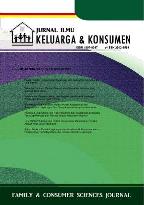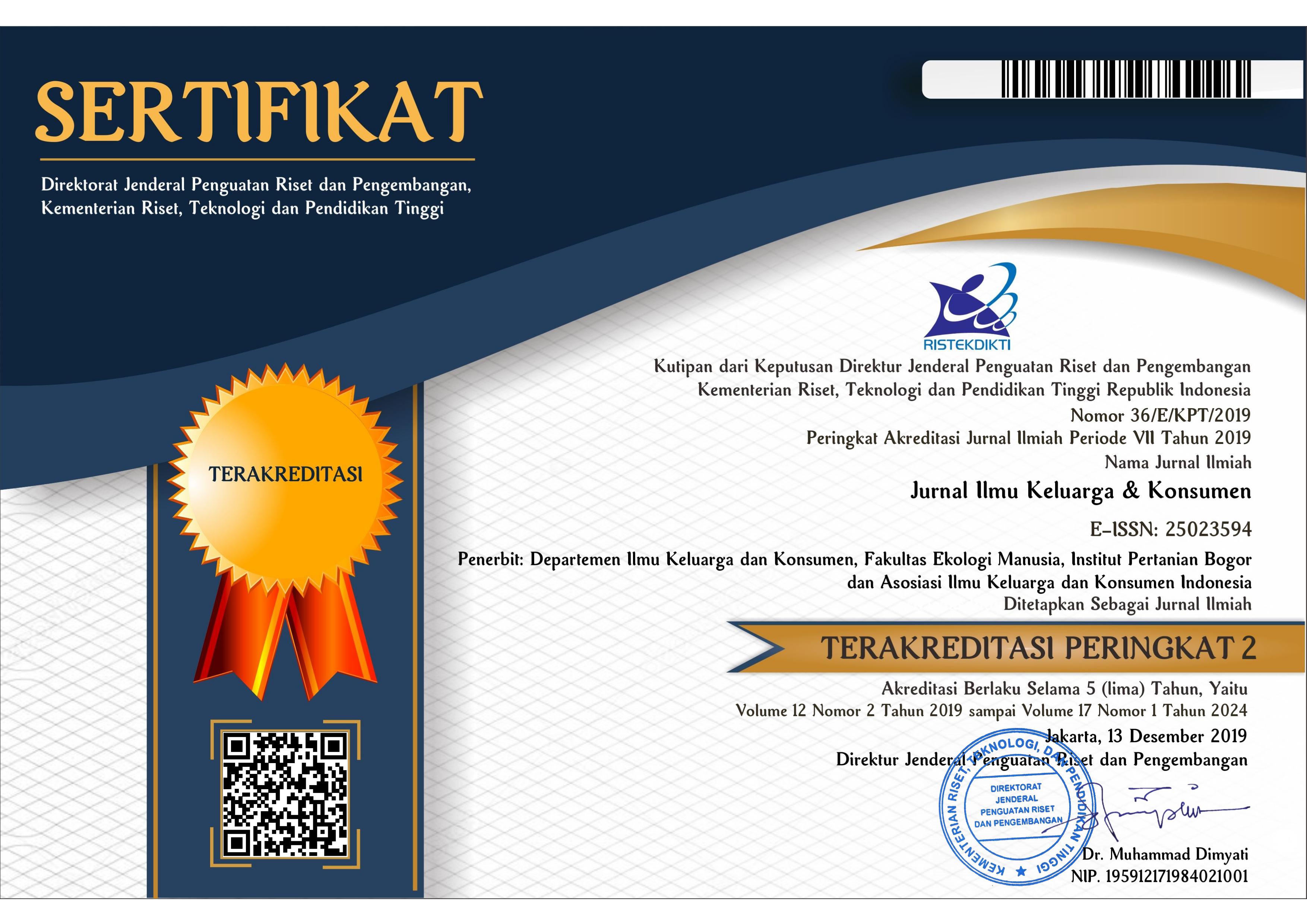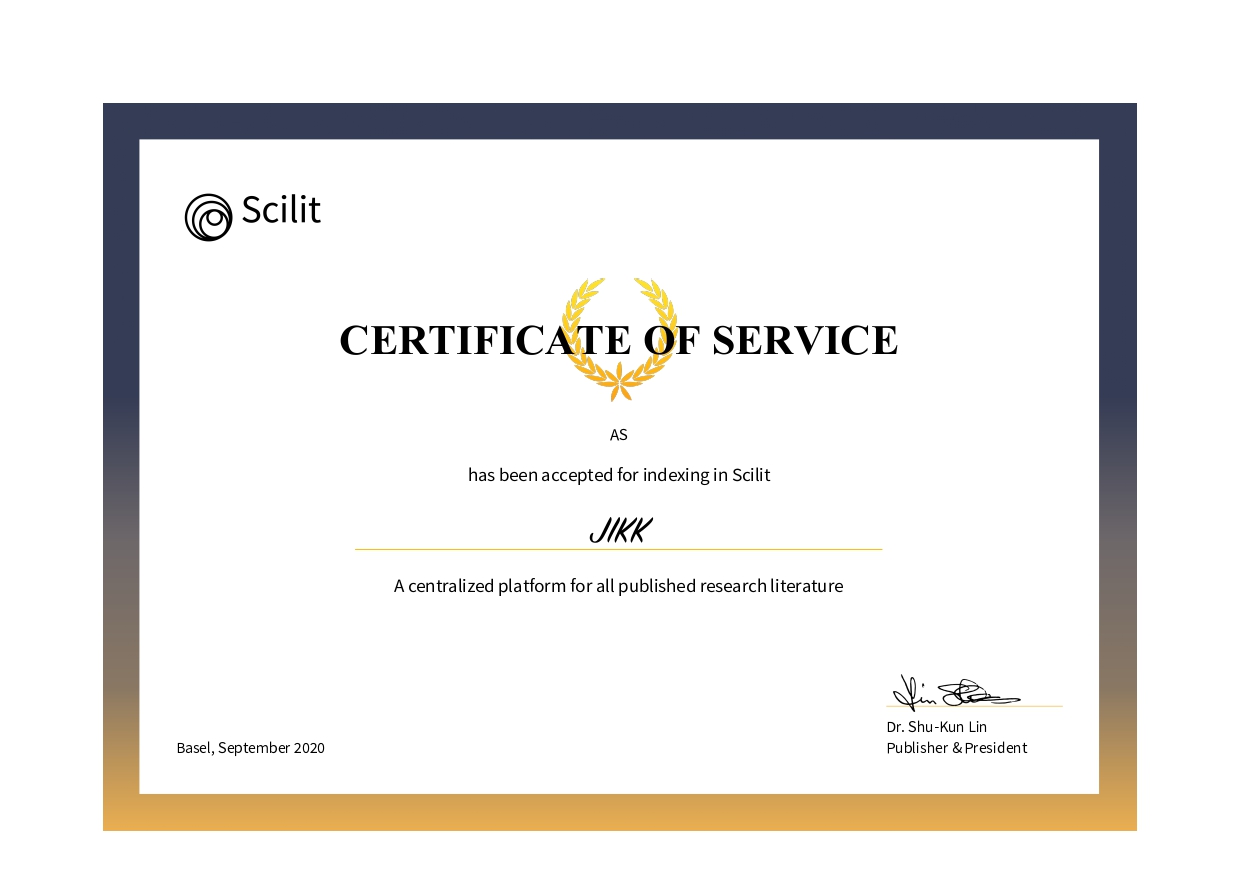Faktor Keluarga, Media, dan Teman dalam Pemilihan Makanan pada Mahasiswa PPKU IPB
Abstract
This study aimed to analyze the influence of family factors media and friends on college student's food choice specifically vegetables. Family factors are assessed from parenting style and parent communication patterns while media and friend factors are judged from the exposure of information obtained by the students. Design of this study was using a quantitative survey. Data were collected by self-administered involving 288 first-year students selected by cluster random sampling. Data were analyzed using descriptive analysis, a different test, and multiple linear regression test. The results showed there was a change in eating habits of students before and after IPB. Before entering the IPB male students tend to eat vegetables with half a bowl serving, while the female students eat vegetables with a serving of one bowl. Almost all student parenting styles applied by parents of male and female students are authoritative parenting style. The results of this study show that more than three-quarters of male and female students have a type of communication pattern of conversation orientation. Male and female students tend to be exposed to information through the media rather than by friends. There is no difference in the exposure of information through media and friends between men and women. This study found three main reasons for the selection of food, especially vegetables in the students of health, mood, and weight control. The results of multiple linear regression test showed that the selection of eating vegetables in students influenced by authoritative parenting style, media, and gender.
References
Baumrind, D. (1972). An exploratory study of socialization effects on Black children: Some Black-White comparisons. Child Development, 43, 261-267.
Benton, D. (2004). Role of parents in the determination of the food preferences of children and the development of obesity. International Journal of Obesity. 28: 858-869.
Biloukha, Oleg, O., & Utermohlen V. (2000). Correlates of food consumtion and perception of food in an educated urban population in Ukraine. Food Quality and Preference, 11, 475-485. Diambil dari http://www.sciencedirect.com/science/article/pii/S0950329300000203. [diunduh 25 Mei 2016].
Badan Ketahanan Pangan Daerah [BKPD]. (2015). Kontribusi sayur dalam pola pangan harapan keluarga Indonesia. [internet]. [diunduh pada 28 April 2016]. Tersedia pada: http://bkpd.jabarprov.go.id/kontribusi-sayur-dalam-pola-pangan-harapan-keluarga-indonesia/
Cutler, G.J., Flood, A., Hannan, P.J., Slavin, J.L., Neumark-Sztainer, D. (2011). Association between major patterns of dietary intake and weight status in adolescents. British Journal of Nutrition. 13: 1–8.
Daniloski, K. M. (2011). Adolescent Food Choice: Developing and Evaluating a Model of Parental Influence (Disertasi). University of. Faculty of Virginia
Eertmans, A. (2006). Sensory-affective and other determinant of food choice: their relative importance and variability across individualsand snd situations. (Disertasi) Chatolic University of Leuven, Leuven.
Elmanora, Muflikhati, I., Alfiasari. (2012). Gaya pengasuhan dan perkembangan sosial emosi anak usia sekolah pada keluarga petani kayu manis. Jurnal Ilmu Keluarga dan Konsumen. 5(2): 128-137
Epstein, L. H., Wisniewski, L., & Weng, R. (1994). Child and parent psychological problem influence child weight control. 2(6), 509-515. Diambil dari http://onlinelibrary.wiley.com/doi/10.1002/j.1550-8528.1994.tb00099.x. [diunduh 25 Mei 2016].
Hadi, H. (2005). Beban ganda masalah kebijakan gizi dan implikasinya terhadap pembangunan kesehatan nasional. Pidato Jabatan Guru Besar Universitas Negeri Yogyakarta
Hawkins, D. I., Best, R. J., & Coney, K. A. (2002). Consumer Behaviour: Building Marketing Strategy. New York: Tata McGraw Hill Companies. 212-215.
Hota, M., & McGuiggan, R. (2005). The Relative Influence of Consumer Socialization Agents on Children and Adolescents – Examining the Past and Modeling the Future. [internet] diakses pada tanggal 15 Januari 2016 http://www.acrwebsite.org/volumes/13831/eacr/vol7/E-07
John, D. R. (1999). Consumer Socialization of Children: a retrospective look at twenty-five years of research. Journal of Consumer Research, 26(3), 183-213.
Koerner, A. F., & Fitzpatrick, M. A. (2002). Understanding family communication patterns and family functioning: The roles of conversation orientation and conformity orientation. 26, 37–68.
Kremes, S. P. J., Bru, J., Vries de H., & Engels, R. C. M. E. (2003). Parenting style and adolescents fruit consumtion. 43-50.
Lyte, L. A., Seifert, S., Greenstein, J., & McGovern, P. (2000). How do children’s eating patterns and food choices change over time? Results from a cohort study. American Journal of Health Promotion 14: 222–228.
Maurer, F.A., & Smith, C.M. (2005). Community Public Health Nursing Practice : Health For Families And Populations. Third Edition
McLeod, J. M., & Chaffee, S. H. (1972). The construction of social reality. In J. Tedeschi. The social influence process, 50-59.
Missagia, S. V., Oliveira de R., & Rezende de D. C. (2012). Food choice motives and healthy eating: Assessing gender differences. 22-26.
Mowen, J. C., & Minor, M. (1998). Consumer Behaviour. Ed ke-5. New Jersey: Prentice Hall.
Nicklas, T. A., Baranowski, J.C., Cullen, K., Rittenberry, L., & Olvera, N. (2001). Family and child-care provider influences on preschool children’s fruit, juice, and vegetable consumption. 59, 224–235.
Pasaribu, R. M., Hastuti, D., & Alfiasari. (2013). Gaya pengasuhan permisif dan rendahnya sosialisasi nilai dalam keluarga beresiko terhadap penurunan karakter remaja. Jur. Ilm. Kel. & Kons. 6 (3): 163-171.
Patrick, Heather, Theresa, A., Nicklas, Sheryl, O. H., & Miriam, M. (2005). The Benefits of Authoritative Feeding Style: Caregiver Feeding Styles and Children's Food Consumption Patterns. 44(2), 243-49.
Perera, T., Madhujith, T. (2012). The Pattern of Consumption of Fruits and Vegetables by Undergraduate Students: A Case Study. 23(3), 261–271.
Raiha, T., Tossavainen, K., Turunen, H., Enkenberg, J., & Halonen, P. (2006). Adolescent’s nutrition health issues: opinion of Finnish seventh-graders. Health Education, 106(2), 114-132.
Ree, M., Riedger, N., & Moghadasian, M. H. (2008). Factors affecting food selection in Canadian Population. Eur J Clin Nutr. 62(1):1255-1262.
Robert, B. S. W., & Williams, S. R. (2000). Nutrition Throughout The Life Cycle. 4th Edition. The McGraw-Hill Book Companies :Inc. Singapore
Robinson, C., Mandleco, B., Olsen, S. F., & Hart, C. H. (1995). Authoritative, authoritarian, and permissive parenting practices: development of a new measure. Psychological Report. 77, 819-830.
Saufika, A., Retnaningsih, Alfiasari. (2012). Gaya hidup dan kebiasaan makan mahasiswa. Jurnal Ilmu Keluarga dan Konsumen, 5 (2):157-165
Scaglioni, S., Salvioni, M., & Galimberti, C. (2008). Influence of parental attitudes in the development of children eating behavior. British Journal of Nutrition. 99: 22-25.
Septiani, I. A. P. (2014). Faktor-faktor yang berhubungan dengan pemilihan makanan pada siswa sekolah menengah atas di kota Yogyakarta. (Tesis]. UGM: Yogyakarta.
Sommer, I., MacKenzie, H., Venter, C., Dean, T. (2012). Factor influencing food choices of food-allergic consumers: findings from focus groups. 67: 1319-1322.
Steptoe, A., Pollard, T. M., & Wardle, J. (1995). Development of a measure of the motives underlying the selection of food: the food choice questionnaire. 25, 267-284.
Sumarwan, U. (2011). Perilaku Konsumen: Teori dan Penerapannya dalam Pemasaran. Ed ke-2. Bogor (ID): Ghalia Indonesia.
Sun, Y. C. (2008). Health concern, food choice motives, and atitudes toward healthy eating: the mediating role of food choice motives. 51(1):42-49.
Ward, S., Donna, M. K., & Daniel, B. W. (1990). Consumer socialization reserach: Content analysis of post-1980 studies, and some implications for future work. Advances in Consumer Research, 17, 798-803.
Ward, S., Donna, M. K., & Daniel, B. W. (1990). Consumer socialization reserach: Content analysis of post-1980 studies, and some implications for future work. Advances in Consumer Research. 17: 798-803
Wrieden, W. (1996). Fruit and vegetable consumption of 10–11 year old children in a region of Scotland. Health Education Journal, 14, 185–19.
Wrieden, W. (1996). Fruit and vegetable consumption of 10–11 year old children in a region of Scotland. Health Education Journal. 14: 185–19
Yuliati, L. N., Retnaningsih, & Aprilia, D. (2012). Pengaruh kelompok acuan terhadap kesadaran dan konsumsi beras merah (Oryza nivara). Jur. Ilmu Keluarga dan Konsumen, 5(2), 166-174
Copyright (c) 2018 Jurnal Ilmu Keluarga & Konsumen

This work is licensed under a Creative Commons Attribution-ShareAlike 4.0 International License.
Authors submitting manuscripts should understand and agree that copyright of manuscripts published are held Jurnal Ilmu Keluarga & Konsumen. The statement to release the copyright to Jurnal Ilmu Keluarga dan Konsumen is stated in Copyright Release Form. Copyright encompass exclusive rights to reproduce, to distribute, and to sell any part of the journal articles in all form and media. The reproduction of any part of this journal is allowed with a written permission from Jurnal Ilmu Keluarga dan Konsumen.









